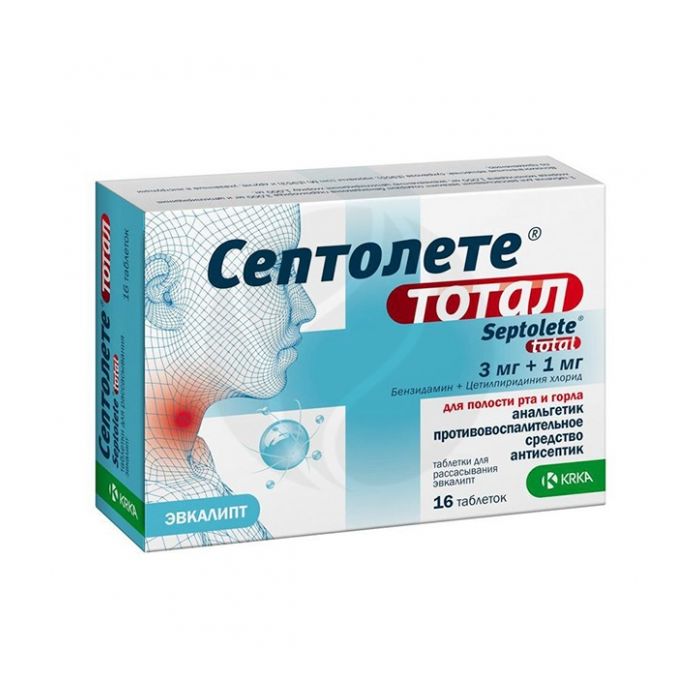Septolete Total tablets for eucalyptus resorption, No. 16
Expiration Date: 05/2027
Russian Pharmacy name:
Септолете Тотал таблетки для рассасывания эвкалипт, №16
The tablets should be slowly dissolved in the mouth every 3-6 hours.
Adults, elderly patients and children over 12 years of age
The recommended dose is 3-4 tablets per day.
Children from 6 to 12 years old
The recommended dose is 3 tablets per day.
Do not exceed the indicated dose.
SeptoleteЃ total should not be used concurrently with other drugs from the antiseptic group.
SeptoleteЃ total should not be used for more than 7 days.
1 eucalyptus lozenge contains:
Active ingredients: Benzydamine hydrochloride 3.000 mg Cetylpyridinium chloride monohydrate 1.050 mg, equivalent to cetylpyridinium chloride 1.000 mg
Excipients: eucalyptus rod-shaped leaves oil, levomenthol, sucralose (E955), citric acid (E330), isomalt (type M) (E953), brilliant blue dye (E133)
Hypersensitivity to active ingredients, or to any auxiliary components of the drug.
Children under 6 years of age.
Carefully
Hypersensitivity to acetylsalicylic acid or other non-steroidal anti-inflammatory drugs, bronchial asthma (including a history).
Pharmacodynamics
Benzydamine is a non-steroidal anti-inflammatory agent that has anti-inflammatory, analgesic and local anesthetic effects. Cetylpyridinium chloride - an antiseptic from the group of quaternary ammonium compounds, has antimicrobial, antifungal, virucidal effect.
Pharmokinetics
Suction
Of the two active ingredients, cetylpyridinium chloride and benzydamine, only benzydamine is absorbed through the mucous membranes. Therefore, cetylpyridinium chloride does not enter into pharmacokinetic interaction with benzydamine at the systemic level.
The absorption of benzydamine through the mucous membranes of the oral cavity and pharynx was shown by identifying the active substance in the blood serum, the amount of which, however, was insufficient to provide a systemic effect. The absorption of benzydamine is higher when using dosage forms that dissolve in the oral cavity compared to dosage forms for topical application (for example, oral spray).
Distribution
The volume of distribution of all dosage forms is the same.
Withdrawal
Excretion occurs mainly by the kidneys, to a greater extent, in the form of inactive metabolites. The half-life and total clearance are similar for all dosage forms.
Overdose
Symptoms: Toxic manifestations of benzydamine overdose include agitation, seizures, increased sweating, ataxia, chills and vomiting. Signs and symptoms of intoxication when ingestion of significant amounts of cetylpyridinium chloride: nausea, vomiting, edema, cyanosis, asphyxia followed by paralysis of the respiratory muscles, depression of the central nervous system, arterial hypotension and coma. The lethal dose for humans is about 1-3 g.
Treatment: in the absence of a specific antidote, treatment of acute intoxication with benzydamine is symptomatic. Treatment of an overdose of cetylpyridinium chloride is also symptomatic. In case of overdose, consult a doctor.
Side effects
Immune system disorders:
frequency unknown: hypersensitivity reactions, anaphylactic reactions.
Nervous system disorders:
frequency unknown: numbness of the oral mucosa.
Respiratory, chest and mediastinal disorders:
rarely: bronchospasm.
Gastrointestinal disorders:
very rare: irritation of the oral mucosa, burning sensation in the mouth.
Skin and subcutaneous tissue disorders:
rarely: urticaria, photosensitivity;
frequency unknown: angioedema, pruritus.

